╔
Tattiche gastrourbanistiche
La trasformazione e la riconversione delle aree di waterfront dismesse rappresentano sfide significative, ma anche opportunità cruciali per migliorare la qualità urbana e rigenerare spazi pubblici [1]. La strategia di utilizzare “eventi locali” come parte di un approccio di “urbanistica temporanea” è una pratica sempre più diffusa per rivitalizzare i waterfront urbani sottoutilizzati in modo rapido, flessibile ed economico [2]. Questo approccio “tattico” si basa sull’organizzazione di eventi temporanei e culturali come festival, mercati, mostre d’arte, concerti o attività sportive, per attirare l’attenzione sulle aree dismesse e creare un senso di comunità e vitalità [3].
Molte città portuali della Danimarca hanno iniziato a sperimentare l’innesto di distretti street food nelle aree di waterfront dismesse come interventi di rigenerazione temporanea volti ad occupare quel lasso di tempo che intercorre tra la dismissione delle infrastrutture obsolete e la progettazione e realizzazione dei progetti di riqualificazione urbana.
Jesper Julian Møller, un visionario ristoratore di Copenaghen, nel 2014 ha preso l’iniziativa di fondare il primo grande centro di street food di Copenaghen sull’isola di Christiansholm sull’Holmen.
Per 300 anni l’isola, denominata Papirøen per la presenza di un sito industriale dedicato allo stoccaggio della carta, è stata interdetta al pubblico. In attesa della realizzazione dell’ambizioso progetto elaborato dallo studio di architettura Cobe (il completamento del progetto è previsto per la fine del 2024), in un brevissimo lasso di tempo l’isola è stata riaperta al pubblico divenendo una delle attrazioni più visitate di Copenaghen: un nuovo quartiere dedicato allo street food di 45.000 mq dove hanno trovato spazio anche mostre d’arte, sfilate di moda, concerti e mercatini delle pulci.
In vista del termine della destinazione temporanea del quartiere gastronomico prevista per il 2017, Møller si è lanciato verso un’altra avventura: puntando gli occhi sull’isola di Refshaleøen, per più di cento anni sede del cantiere navale Burmeister & Wain che ha chiuso i battenti nel 1996, dal 2018 ha dato vita al mercato di street food Reffen.
Il progetto del nuovo distretto del cibo è più ambizioso del precedente. Reffen funziona da incubatore di piccole imprese e mira a contribuire il più possibile allo sviluppo economico e alla vita culturale della città.
Il contratto di locazione dell’area ha una durata di dieci anni durante i quali, ogni tre anni, verranno selezionati ristoratori e start-up alimentari in base a criteri di sostenibilità, cucina circolare, prodotti freschi, locali e organici – con un occhio di riguardo per i vegetariani – e design curato e accattivante (tutte caratteristiche che distinguono la cucina danese contemporanea!). Ciascuna impresa avrà tre anni di tempo per consolidarsi e verificare se la propria offerta funziona. Attualmente nel mercato sull’acqua, esteso 10.000 metri quadrati, sono attivi cinquanta mini-ristoranti, bancarelle e start-up diversi – alcuni dei quali gestiti da una sola persona – che rappresentano le cucine di tutto il mondo su un’isola. Tutte le bancarelle devono seguire i dogmi sostenibili “riduci e riutilizza”.
Contemporaneamente a Reffen, nella Grønlandske Handels Plads di Copenaghen ha preso piede il distretto street food Broens Gadekøkken, nei pressi del ponte Inderhavnsbroen tra Christianshavn e Nyhavn. Il distretto si ispira all’antico mercato che era situato nella “Piazza del Commercio Groenlandese”, un importante episodio della storia commerciale di Copenaghen che testimonia l’antica relazione tra la città e le terre artiche. Qui, tra il XVIII e XIX secolo, i commercianti provenienti dalla Groenlandia, dall’Islanda, dalle Isole Fær Øer e dalla Danimarca arrivavano dopo lunghi viaggi attraverso gli oceani per vendere e scambiare merce (pesce essiccato, aringhe salate, carni e pelli di balena e di foca), dando vita ad un animato mercato che rifletteva le relazioni commerciali tra la Danimarca e le colonie danesi.
The transformation and reconversion of abandoned waterfront areas represent significant challenges, but also crucial opportunities to improve urban quality and regenerate public spaces [1]. The strategy of using “local events” as part of a “temporary urbanism” approach is an increasingly popular practice for revitalizing underused urban waterfronts quickly, flexibly and affordably [2]. This “tactical” approach is based on the organization of temporary and cultural events such as festivals, markets, art exhibitions, concerts or sporting activities, to draw attention to brownfield sites and create a sense of community and vitality [3].
Many port cities in Denmark have started to experiment with the inclusion of street food districts in abandoned areas of the waterfront as temporary regeneration interventions aimed at occupying that period of time between the decommissioning of obsolete infrastructures and the design and implementation of urban redevelopment projects.
Jesper Julian Møller, a visionary chef from Copenhagen, took the initiative in 2014 to establish Copenhagen’s first large street food center on Christiansholm Island in Holmen.
For 300 years the island, called Papirøen due to the presence of an industrial site dedicated to paper storage, remained closed to the public. While waiting for the realization of the ambitious project designed by the Cobe architecture studio (the project is expected to be completed by the end of 2024), in a very short time the island was reopened to the public, becoming one of the most visited attractions in Copenhagen: a new 45,000 m2 district dedicated to street food where space has also been given to art exhibitions, parades, concerts and markets.
With the temporary destination of the food district set to end in 2017, Møller has embarked on another adventure: setting his sights on the island of Refshaleøen, for more than a hundred years home to the Burmeister & Wain shipyard which closed its doors in 1996, since 2018 he has opened the Reffen street food market.
The new food district project is more ambitious than the previous one. Reffen functions as a small business incubator and aims to contribute as much as possible to the economic development and cultural life of the city.
The lease of the area has a duration of ten years during which, every three years, restaurateurs and food startups will be selected based on sustainability criteria, circular cuisine, fresh, local and organic products – with an eye to vegetarians – and attractive design (all characteristics that distinguish contemporary Danish cuisine!). Each company will have three years to consolidate and verify whether their offer works. Currently, in the 10,000 square meter water market there are fifty different mini-restaurants, stalls and start-ups – some of them run by a single person – representing cuisines from around the world on one island. All stands must follow the sustainable principles of “reduce and reuse”.
At the same time as Reffen, the street food district Broens Gadekøkken took hold in Copenhagen’s Grønlandske Handels Plads, near the Inderhavnsbroen bridge between Christianshavn and Nyhavn. The market is inspired by the ancient market that was located in the “Greenlandic Trade Square”, an important episode in the commercial history of Copenhagen which testifies to the ancient relationship between the city and the arctic lands. Here, between the 18th and 19th centuries, traders from Greenland, Iceland, the Fær Øer Islands and Denmark arrived after long journeys across the oceans to sell and exchange goods (dried fish, salted herring, whale and seal meat and skins), resulting in a lively market that reflected the trade relations between Denmark and the Danish colonies.
Mappa dei distretti street food della Danimarca aperti in aree portuali per la rigenerazione dei waterfront. (Elaborazione grafica di A. Badami).
Map of street food districts in Denmark opened in port areas for the regeneration of the waterfront. (Map design of A. Badami).
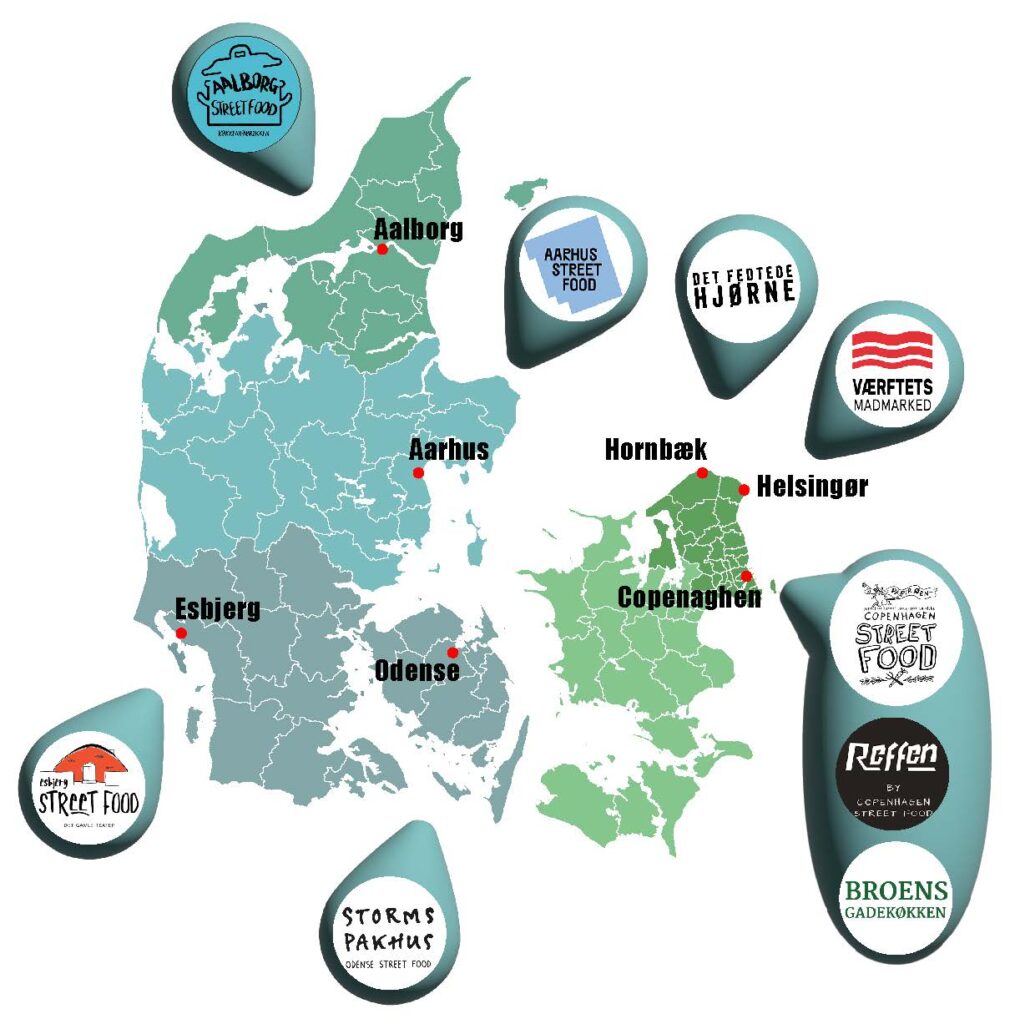
Oltre alla capitale, il giro del mondo culinario prosegue in altre strutture portuali dismesse che oggi ospitano mercati temporanei di street food. All’interno dell’ex cantiere navale di Helsingør, all’estremità orientale della Danimarca, si apre il Værftets Madmarked, con soffitti alti rivestiti con materiali riciclati da vecchie barche e casse di imballaggio. Poco più a ovest, sulla spiaggia di Hornbæk, vicino al porto turistico si trova il ristorante Det Fedtede Hjørne, letteralmente “l’angolo del grasso” per il suo passato di ristorante di polli alla griglia, che oggi offre sei diversi stand gastronomici, un bar ben fornito e vari eventi di musica dal vivo.
Al centro della Danimarca, ospitato nei vecchi garage degli autobus vicino alla Aarhus Rutebilstation, Aarhus Street Food è un mercato permanente di cibo di strada con più di 30 cucine da tutto il mondo. All’estremità occidentale del paese, i 2000 mq del Vecchio Teatro presente nei pressi del porto di Esbjerg oggi accolgono sette bancarelle, tre bar e cinquantasette spillatori di birra dell’Esbjerg Street Foods.
Nello Yutland settentrionale è Aalborg Street Food Køkkenfabrikken, il mercato di cibo da strada di Aalborg, che offre spazio a più di seicento avventori all’interno della ex fabbrica di mobili Boform situata all’interno dell’atmosfera marittima dell’area portuale di Skudehavnen.
In addition to the capital, the culinary world tour continues in other disused port structures which today host temporary street food markets. Værftets Madmarked was set up inside the former shipyard in Helsingør, on the eastern edge of Denmark, with high ceilings covered with recycled materials from old boats and packing crates. A little further west, on Hornbæk beach, near the marina is the restaurant Det Fedtede Hjørne, literally “fat corner” due to its past as a grilled chicken restaurant, offering today six different food stalls, a well-stocked bar and various live music events.
In central Denmark, housed in old bus garages near Aarhus Rutebil station, Aarhus Street Food is a permanent street food market featuring more than 30 cuisines from around the world. In Esbjerg, at the western end of the country, the 2000 m2 of the Old Theatre near the port now houses seven stalls, three bars and fifty-seven beer taps in the Esbjerg Street Foods.
In Northern Yutland there is Aalborg Street Food Køkkenfabrikken, the street food market of Aalborg which offers space to more than six hundred customers inside the former Boform furniture factory, located in the maritime atmosphere of the port area of Skudehavnen.
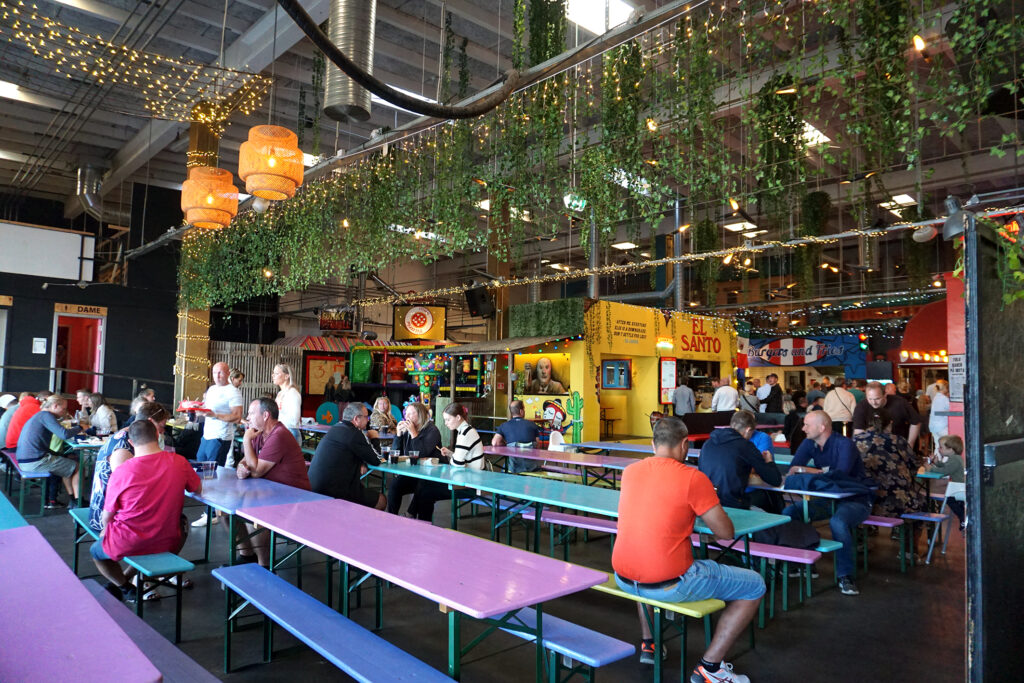
Area attrezzata con panche colorate del mercato alimentare Street Food Køkkenfabrikken ospitato all’interno della ex fabbrica di mobili Boform nell’area portuale Skudehavnen ad Aalborg. (Photo A. Badami, 2022).
Food court with colorful benches of the Street Food Køkkenfabrikken market housed within the former Boform furniture factory in Aalborg’s Skudehavnen dock area. (Photo: A. Badami, 2022).
Bancarella di anatra sfilacciata, grasso d’anatra e patatine fritte del mercato alimentare Street Food Køkkenfabrikken di Aalborg. (Photo: A. Badami, 2022).
Pulled duck, duck fat and chips stall at Aalborg’s Street Food Køkkenfabrikken market. (Photo: A. Badami, 2022).
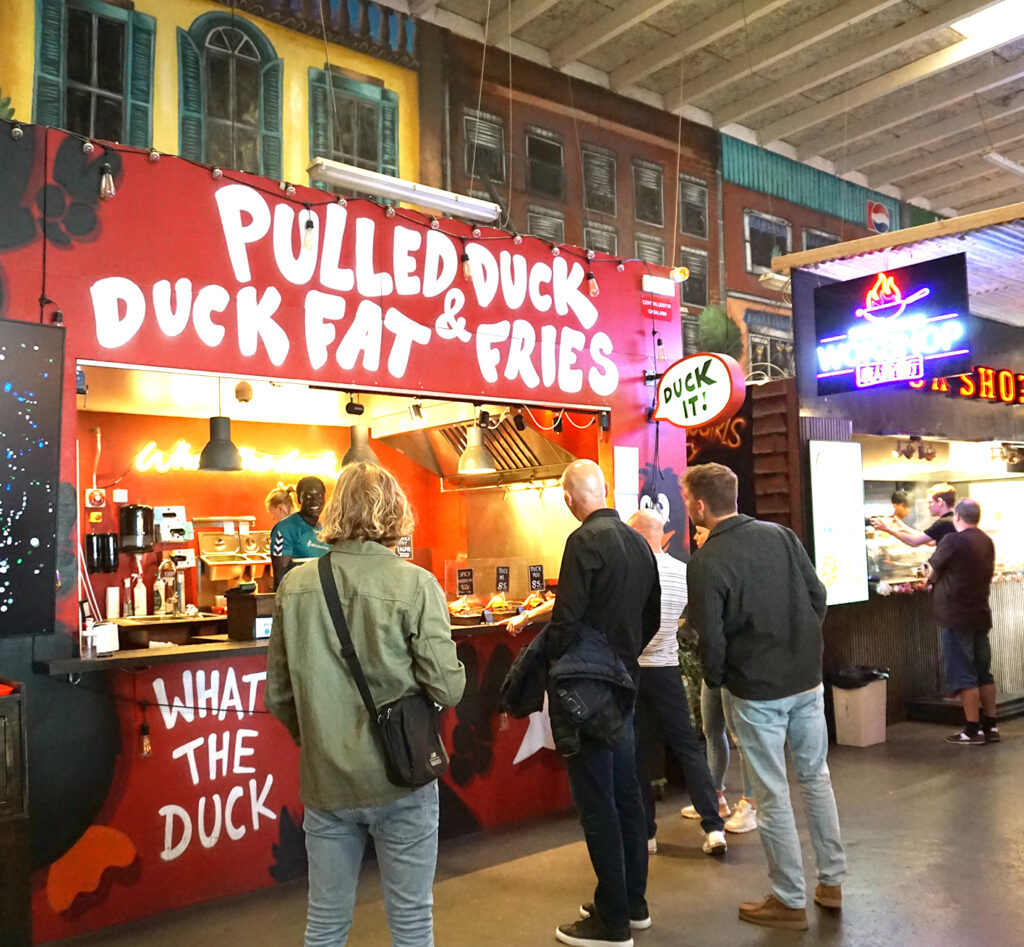
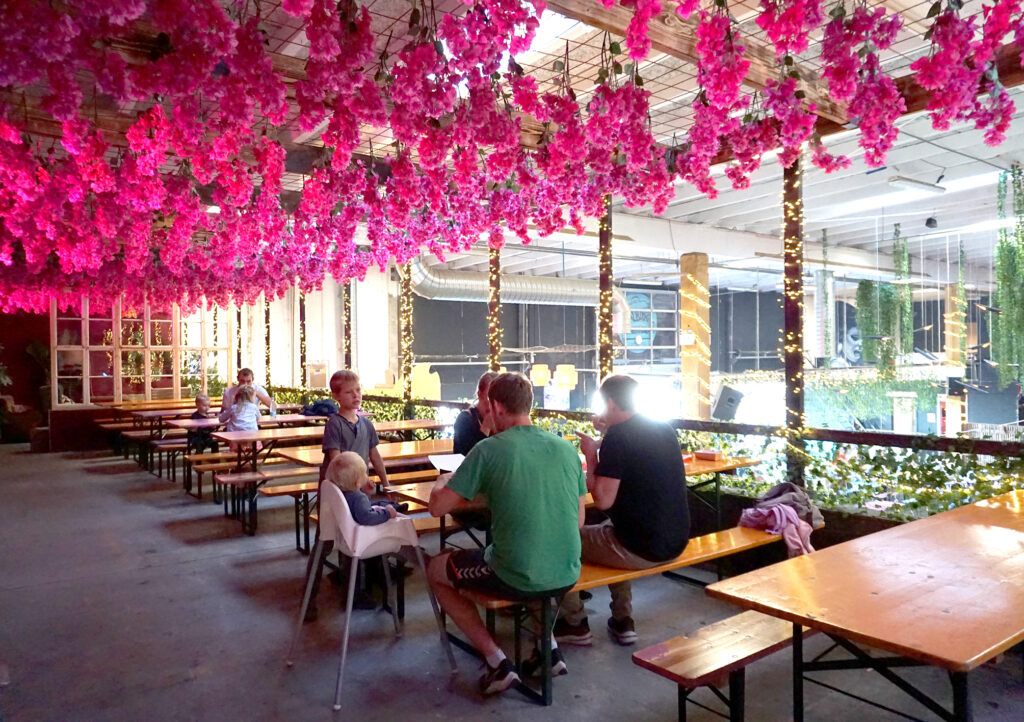
Mezzanino del mercato alimentare Street Food Køkkenfabrikken di Aalborg attrezzato con panche per la consumazione sul posto. (Photo A. Badami, 2022).
Mezzanine of the Street Food Køkkenfabrikken market in Aalborg equipped with stalls for on-site consumption. (Photo: A. Badami, 2022).
A Fyn, la seconda isola della Danimarca, Odense accoglie, all’interno dei 3000 mq dell’ex-magazzino Storms vicino al porto, il mercato alimentare gastronomico e creativo Storms Pakhus con i suoi ventiquattro stand gastronomici, sei bar e dodici laboratori creativi. Anche Storms Pakhus è un incubatore per imprenditori locali e ristoratori emergenti e promuove una cucina moderna e accessibile a partire dagli ingredienti offerti dall’isola di Fyn e dalle sue straordinarie tradizioni culinarie.
In tutti questi villaggi gastronomici si può gustare il meglio dello street food elaborato nei quattro angoli del mondo. Si può spaziare dai tradizionali smørrebrød danesi ai classici hamburger, fish&chips, pizza e hotdog. Ci si può avventurare tra le specialità cubane, thailandesi, marocchine, coreane, argentine, caraibiche, brasiliane, colombiane, giamaicane, ghanesi, marocchine, italiane, francesi, turche, indiane, cinesi, giapponesi, messicane, vietnamite, spagnole, libanesi fino a perdersi nel soul-food americano. Il tutto immerso nella tradizionale atmosfera danese hygge, con in mano una fumante tazza di caffè o una buona birra artigianale accomodati su una sedia a sdraio aperta sull’orizzonte del mare.
Tutte queste iniziative hanno riscosso sin da subito un grande successo di pubblico dando anche prova che la promozione dello street food come parte di una strategia di urbanistica “temporanea” è un modo efficace per avviare il processo di riqualificazione dei waterfront urbani sottoutilizzati. Questo approccio combina l’attivazione rapida dello spazio con il coinvolgimento di comunità multietniche e offre un percorso verso la trasformazione e il recupero delle aree di waterfront inaccessibili in luoghi più vivaci e inclusivi per tutte le culture che abitano le città.
A volte, una buona pianificazione in una città significa semplicemente lasciare spazio alle persone.
In Funen, Denmark’s second largest island, Odense welcomes the Storms Pakhus gastronomic and creative market with its twenty-four food stands, six bars and twelve creative workshops, within the 3000 m2 of the former Storms warehouse near the port. Storms Pakhus is also an incubator for local entrepreneurs and emerging restaurateurs and promotes modern and accessible cuisine starting from the ingredients offered by the island of Funen and its extraordinary culinary traditions.
In all these gastronomic villages you can taste the best of street food developed in the four corners of the world. You can range from traditional Danish smørrebrød to classic burgers, fish & chips, pizza and hotdogs. You can venture into Cuban, Thai, Moroccan, Korean, Argentinian, Caribbean, Brazilian, Colombian, Jamaican, Ghanaian, Moroccan, Italian, French, Turkish, Indian, Chinese, Japanese, Mexican, Vietnamese, Spanish, Lebanese flavors and even into American soul food. All immersed in the traditional Danish hygge atmosphere, with a cup of steaming coffee or a good craft beer in hand while sitting on an outdoor deckchair overlooking the sea horizon.
All these initiatives immediately met with great public success, also demonstrating that the promotion of street food as part of a “temporary” urban planning strategy represents an effective way to start the redevelopment process of underused urban waterfronts. This approach combines the rapid activation of space with the involvement of multi-ethnic communities and offers a path towards transforming inaccessible waterfront areas into more vibrant and inclusive places for all cultures that populate cities.
Sometimes, good planning in a city simply means making room for people.
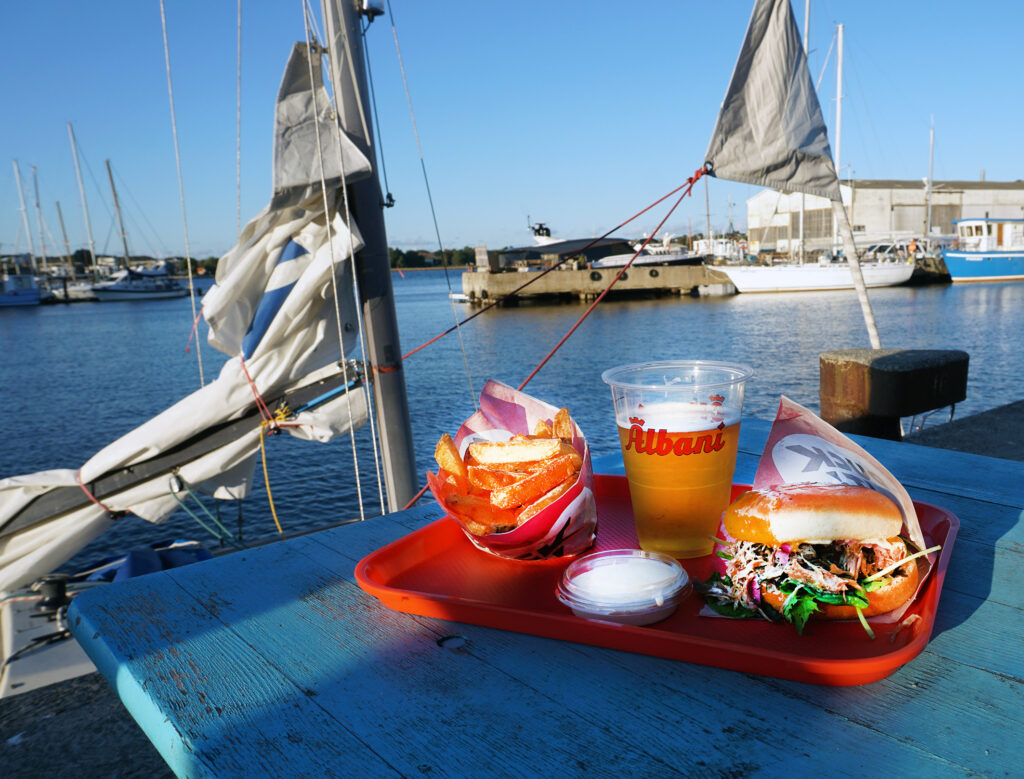
Hamburger di anatra sfilacciata con salsa di formaggio fuso e patatine fritte sulle panche della zona esterna del mercato alimentare Street Food Køkkenfabrikken aperto sulla marina di Skudehavnen ad Aalborg. (Photo A. Badami, 2022).
Pulled duck burger with melted cheese sauce and french fries on benches in the outdoor area of the Street Food Køkkenfabrikken market on the waterfront of the Skudehavnen marina in Aalborg. (Photo: A. Badami, 2022).
IMMAGINE INIZIALE | Piatti da asporto dallo stand The Fish Project al mercato Street Food Køkkenfabrikken di Aalborg. (Foto: A. Badami, 2022).
HEAD IMAGE | Takeaway dishes from The Fish Project stand at the Street Food Køkkenfabrikken market in Aalborg. (Photo: A. Badami, 2022).
╝
NOTE e RIFERIMENTI
NOTES and REFERENCES
[1] Rey E., Laprise M., Lufkin S. (2022). “Urban Brownfields: Origin, Definition, and Diversity”. In: Rey E., Laprise M., Lufkin S. (edited by), Neighbourhoods in Transition. The Urban Book Series. Springer, Cham. https://doi.org/10.1007/978-3-030-82208-8_2.
[2] Liu G., Yang Y., Li K., Shrestha A., Zhuang T. (2024). “Prosperity or futility? Effects of micro-regeneration on neighborhood commercial vitality”. Engineering, Construction and Architectural Management. https://doi.org/10.1108/ecam-09-2023-0922.
[3] Ragab T. S. (2022). “Modeling Tactical Urbanism: A Contemporary Approach for Urban Regeneration”. In: Mady M., Fekry M., Ibrahim A. (edited by), Cities of the Future. Cham: Springer International Publishing, pp. 153–167. https://doi.org/10.1007/978-3-031-15460-7_11.
[1] Rey E., Laprise M., Lufkin S. (2022). “Urban Brownfields: Origin, Definition, and Diversity”. In: Rey E., Laprise M., Lufkin S. (edited by), Neighbourhoods in Transition. The Urban Book Series. Springer, Cham. https://doi.org/10.1007/978-3-030-82208-8_2.
[2] Liu G., Yang Y., Li K., Shrestha A., Zhuang T. (2024). “Prosperity or futility? Effects of micro-regeneration on neighborhood commercial vitality”. Engineering, Construction and Architectural Management. https://doi.org/10.1108/ecam-09-2023-0922.
[3] Ragab T. S. (2022). “Modeling Tactical Urbanism: A Contemporary Approach for Urban Regeneration”. In: Mady M., Fekry M., Ibrahim A. (edited by), Cities of the Future. Cham: Springer International Publishing, pp. 153–167. https://doi.org/10.1007/978-3-031-15460-7_11.